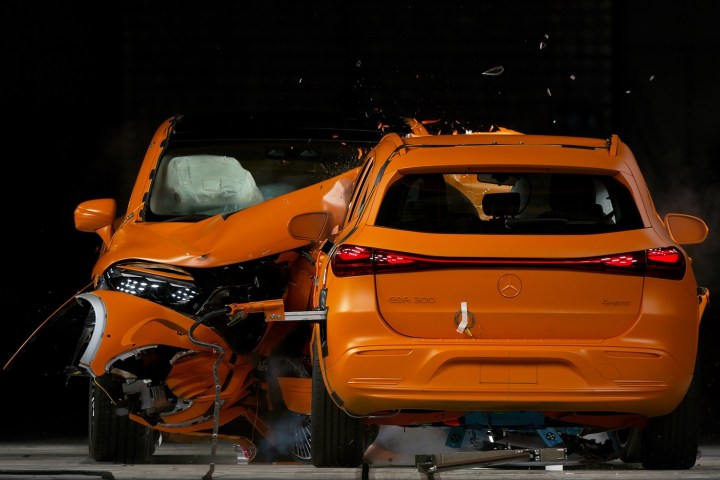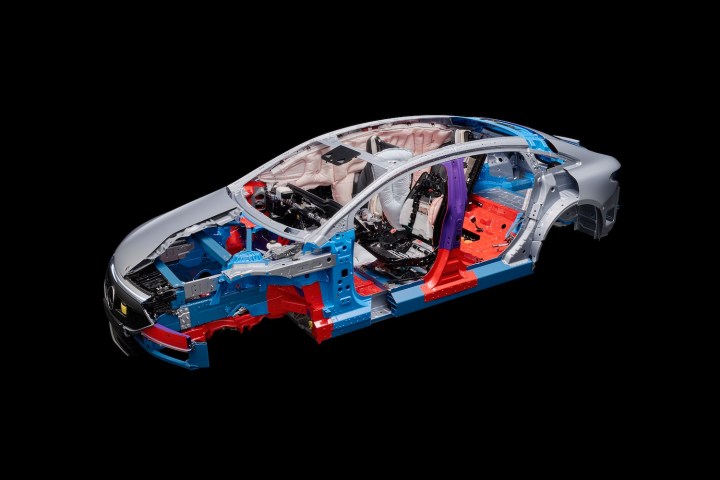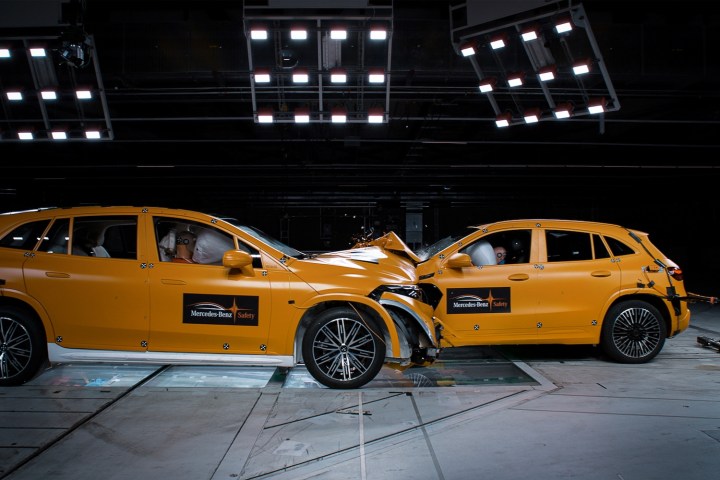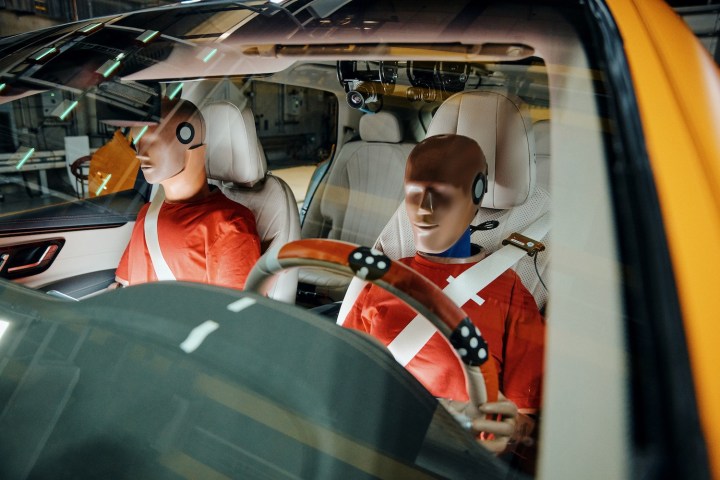
A flash of light, a big bang, and it’s over. Two SUVs lie askew on a patch of concrete, a debris field scattered between them. They’ve just been in a head-on collision, the moment captured by high-speed cameras aided by blindingly bright lights. That’s what a successful day looks like at the Mercedes-Benz crash-test lab in Sindelfingen, Germany.
While spectacular and jarring, crash-tests aren’t special. Mercedes averages three per day at this facility, giving engineers plenty of data from onboard sensors and crash-test dummies to analyze behind closed doors. But this test was different.
The two cars sacrificed for safety were electric, and Mercedes invited Digital Trends and other media outlets to watch them get smashed. It’s rare for automakers to let any outsiders watch a live crash-test, so much so that Mercedes claims it is the first automaker to publicly conduct a crash-test of this type between two EVs. It set up this spectacle of destruction to prove that EVs are just as safe as gasoline cars.
Safer cars regardless of what powers them
From a lack of engine noise to swapping gas pumps for chargers, EVs are changing a lot about the driving experience that we take for granted. But safety has to remain the same. High safety standards are mandatory in most major markets, and it’s become a major selling point for automakers that know customers will pay a premium for a car with the highest safety ratings.

“Safety is not a question of the drivetrain for us,” Julia Hinners, passive safety engineer at Mercedes, said while standing next to a Mercedes EQS electric sedan with doors that been caved in by a side impact.
Mercedes has set a goal of zero fatalities in its cars by 2050, and it has dubbed the endeavor “Vision Zero.” If it achieves that goal, it will likely happen with an all-electric lineup. The automaker in 2021 announced plans to go all-electric by 2030 in at least some markets. But the two goals aren’t dependent on each other. Hinners said Mercedes would still be aiming for zero fatalities if it was still making only gasoline cars. It just happens to be shifting to EVs in anticipation of stricter emissions rules.
Safety still starts with the structure
Mercedes has fielded some notable safety innovations over the years, becoming the first automaker to add crumple zones to production cars in 1959. But there’s no technological silver bullet for making EVs safer. Engineers approach EV crash protection the same way as with gasoline cars, by designing the vehicle’s structure to absorb and disperse crash forces.

“It’s not only a challenge,” Hinners said of working on EVs, “it’s a lot more opportunity.”
Take the front end. With no engine, the basic structure had to be redesigned for EVs, specifically with bigger longitudinal rails. But the lack of an engine also meant these components and others could be made in whatever shape engineers wanted, Hinners explained.
Protecting occupants and the battery
However, EVs also include an added wrinkle for crash safety engineers: the battery pack. Much like the fuel tanks in internal-combustion cars, the large, heavy pack needs to be protected from damage in order to lessen the chance of fire.
High-voltage wires running from the pack are kept in the center of the car, away from crumple zones.
Like most automakers, Mercedes places the battery packs in its EVs under the floor. This means one of the biggest structural changes compared to an internal-combustion car is actually in the side sills beneath the doors. They’re quite large, with a honeycomb-like cross section that allows them to absorb the energy of a side impact, shielding the pack. The high-voltage wires running from the pack are also kept in the center of the car, away from crumple zones that could deform on impact and damage them.
Battery packs add a lot of weight — a Mercedes EQB weighs 871 pounds more than its gasoline GLB250 4Matic counterpart — but that isn’t a concern for the safety engineers. If anything, the added mass low in the vehicle helps with side-impact and rollover crash-test performance by lowering the center of gravity, Hinners said.
Lights, camera, destruction
All of these features are about to be put to the test. We’re standing on an observation platform in the warehouse-like crash-test facility. Below, a Mercedes EQS SUV and an EQA (a smaller model not sold in the U.S.) face off. They’ll be pulled into each other by cables in the floor at 35 mph before colliding with a 50% offset. That means about half of the front end of each car will overlap.
The spot where the wheel would normally be located looks like it’s been punched by the Hulk.
This is a bit more dramatic than the normal crash-tests used to confirm compliance with safety regulations and to generate the crash-test ratings you see in new car ads. Cars usually aren’t crashed into each other; they’re either crashed into stationary bollards or hit by sleds with deformable faces meant to simulate other vehicles. Safety organizations can also have different parameters. The Insurance Institute for Highway Safety (IIHS) specifies a 40 mph speed and 40% offset in its moderate overlap frontal crash-test — that’s a higher speed than the Mercedes test, with less of the car’s front end absorbing the impact.

Because each car is traveling at 35 mph when they collide, the force of the impact is equivalent to driving into a wall at 70 mph. Physics flings both cars to either side of the test track’s centerline, ejecting headlights and the EQA’s driver’s-side front wheel, which comes to rest a few feet away with its brake rotor and caliper still attached. The spot where the wheel would normally be located looks like it’s been punched by the Hulk. The EQS SUV’s hood is curled like a metal potato chip, while the arm of a crash -test dummy hangs down listlessly below a curtain airbag in a twisted tableau. But all is well.
Post-crash analysis
Once firefighters and an electrician have checked the cars out (the high-voltage electronics are designed to shut off automatically if the airbags deploy, but first responders can also manually disconnect power by cutting a cable behind one of the roof pillars), we get an up-close look at the aftermath.

Like all modern cars, the Mercedes EVs are designed to shed parts and sacrifice sheet metal to keep the forces of an impact from reaching the people inside. The amount of wreckage makes the scene look pretty bad, but actual drivers and passengers would have likely avoided serious injuries, according to the Mercedes engineers.
Mercedes did have a forklift on hand to plunge burning cars into a nearby pool, but that proved unnecessary.
The damage also basically stops at the front ends of both cars. All four doors on both the EQS SUV and EQA are easily opened, which would be critically important in a real-life crash, but also shows that the front crash structures absorbed most of the impact as designed. And while the EQA is bleeding pink battery coolant, the packs in both cars are intact. Mercedes did have a forklift on hand to plunge burning cars into a nearby pool, but that proved unnecessary.
Electrification can’t compromise safety
It’s reassuring to see car safety features work as intended, but we weren’t expecting any surprises. The fact that Mercedes invited media to watch a live crash-test indicates a high level of confidence that nothing would go wrong. Whether its technology demonstrations or first drives of new cars, automakers generally don’t present something to journalists unless it’s fully sorted, as a failure would generate bad coverage.

This is also just one test, and one that doesn’t conform to any crash-test standard. Mercedes officials pointed out that this test involved more force than comparable tests needed to certify cars for sale in major markets, and it’s definitely a plausible real-world scenario, but it can’t be compared to new-car safety ratings. At press time, the IIHS and the federal National Highway Traffic Safety Administration (NHTSA) hadn’t published safety ratings for any of the Mercedes EQ models sold in the U.S. EVs from other manufacturers have done well in the IIHS’ stricter tests, though.
Caveats aside, this crash demonstration illustrates an important fact about EVs: they’re still cars. Decades of safety development is being carried forward to EVs, even if a century of internal-combustion engine development is being relegated to the dusty shelves of history. It’s not often discussed, but this is a crucial part of the EV revolution. Because if EVs aren’t as safe as today’s gasoline-burning cars, we’ll be taking a step backward.
Editors' Recommendations
- Mercedes G580 electrifies an off-road icon
- Mercedes-Maybach EQS SUV is old-school luxury — electrified
- 2023 Mercedes-Benz EQE SUV preview: The EV lineup grows again
- Mercedes-Benz EQS SUV is a luxury SUV for the family
- Jeep built a monster electric prototype to show what EVs can really do off-road



